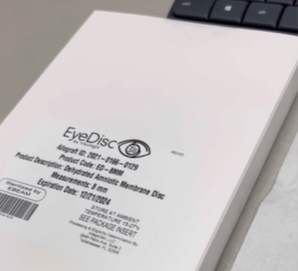Overview
Our dehydrated amniotic membrane allografts are flat and available in disc, rectangle or square shapes. The origins of our product begin with an act of a placental donation from a birth mother giving through a planned Cesarean delivery. The Amniotic Membrane itself is avascular and contains cytokines and growth factors (epidermal, keratinocyte, transforming growth factor beta, vascular endothelial growth factor and platelet derived growth factor). It is in these key growth factors that ocular tissue growth and healing are facilitated. Amniotic Membranes also have anti-microbial and anti-inflammatory properties.
All of our tissues are chorion free and screened for diseases before treating them with broad-spectrum antibiotics. We provide our dehydrated amniotic membrane allografts in products from human amniotic tissue in 5 different disc oriented sizes – 5mm, 8mm, 12mm and 16mm; and 3 different EyeGraft sizes 1.5x2cm, 2x3cm and 4x4cm.



